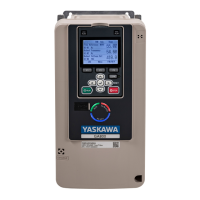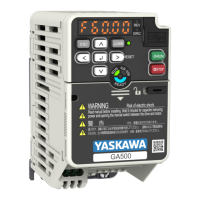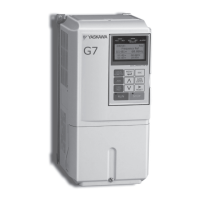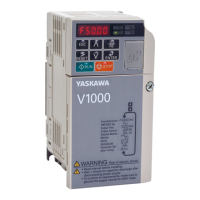5 Common Drive Specifications
YASKAWA TOEPC7106170VA GA800 600 V Drive Installation & Primary Operation 11
Item Specification
Starting Torque
• V/f: 150%/3 Hz
• CL-V/f: 150%/3 Hz
• OLV: 200%/0.3 Hz
• CLV: 200%/0 min
-1
(r/min)
• AOLV: 200%/0.3 Hz
Note:
Correctly select the drive and motor capacity for this starting torque in these control methods:
• OLV
• CLV
• AOLV
Speed Control Range
• V/f: 1:40
• CL-V/f: 1:40
• OLV: 1:200
• CLV: 1:1500
• AOLV: 1:200
Zero Speed Control
Possible in CLV control method
Torque Limits
Parameter settings allow different limits in four quadrants in these control methods:
• OLV
• CLV
• AOLV
Accel/Decel Time
0.0 s to 6000.0 s
The drive can set four pairs of different acceleration and deceleration times.
Braking Torque
Approximately 20%
Approximately 125% with a dynamic braking option
• Short-time average deceleration torque
Motor output 0.4/0.75 kW: over 100%
Motor output 1.5 kW: over 50%
Motor output 2.2 kW and larger: over 20%, Overexcitation Braking/High Slip Braking allow for approximately 40%
• Continuous regenerative torque: Approximately 20%. Dynamic braking option allows for approximately 125%, 10%ED, 10 s
WARNING
Set L3-04 = 0 [Stall Prevention during Decel = Disabled] when you operate the drive with:
• a regenerative converter
• regenerative unit
• braking unit
• braking resistor
• braking resistor unit.
If you set the parameter incorrectly, the drive can decelerate for too long and cause serious injury or death.
Note:
• Short-time average deceleration torque refers to the torque needed to decelerate the motor (uncoupled from the load) from the rated speed to zero. Motor
characteristics can change the actual specifications.
• Motor characteristics change the continuous regenerative torque and short-time average deceleration torque for motors 2.2 kW and larger.
V/f Characteristics
Select from 15 pre-defined V/f patterns, or a user-set V/f pattern.
Main Control
Functions
Torque Control, Droop Control, Speed/Torque Control Switching, Feed Forward Control, Zero Servo Function, Restart After Momentary Power Loss, Speed
Search, Overtorque/Undertorque Detection, Torque Limit, 17 Step Speed (max.), Accel/Decel Switch, S-curve Acceleration/Deceleration, 3-wire Sequence,
Auto-Tuning (Rotational and Stationary), Dwell Function, Cooling Fan ON/OFF Switch, Slip Compensation, Torque Compensation, Frequency Jump, Upper/
Lower Limits for Frequency Reference, DC Injection Braking at Start and Stop, Overexcitation Braking, High Slip Braking, PID Control (with Sleep
Function), Energy Saving Control, MEMOBUS/Modbus Communication (RS-485 max, 115.2 kbps), Auto Restart, Application Presets, DriveWorksEZ
(customized functions), Removable Terminal Block, Online Tuning, KEB, Overexcitation Deceleration, Inertia (ASR) Tuning, Overvoltage Suppression, High
Frequency Injection
Table 5.2 Protection Functions
Item Specification
Motor Protection
Electronic thermal overload protection
Momentary
Overcurrent
Protection
Drive stops when the output current is more than 200% of the HD output current.
Overload Protection
Drive stops when the output current is more than these overload tolerances:
• HD: 150% of the rated output current for 60 seconds. The permitted frequency of overload is one time each 10 minutes.
• ND: 110% of the rated output current for 60 seconds. The permitted frequency of overload is one time each 10 minutes.
Note:
• If output frequency < 6 Hz, the drive can trigger the overload protection function when the output current is in the overload tolerance range.
• Derating may be necessary for applications that start and stop frequently.
Overvoltage
Protection
600 V class: Stops when the DC bus voltage is more than approximately 1040 V
Undervoltage
Protection
600 V class: Stops when the DC bus voltage decreases to less than approximately 460 V

